Table of Contents:
What Should I Do If My Dog Ate a Bee?
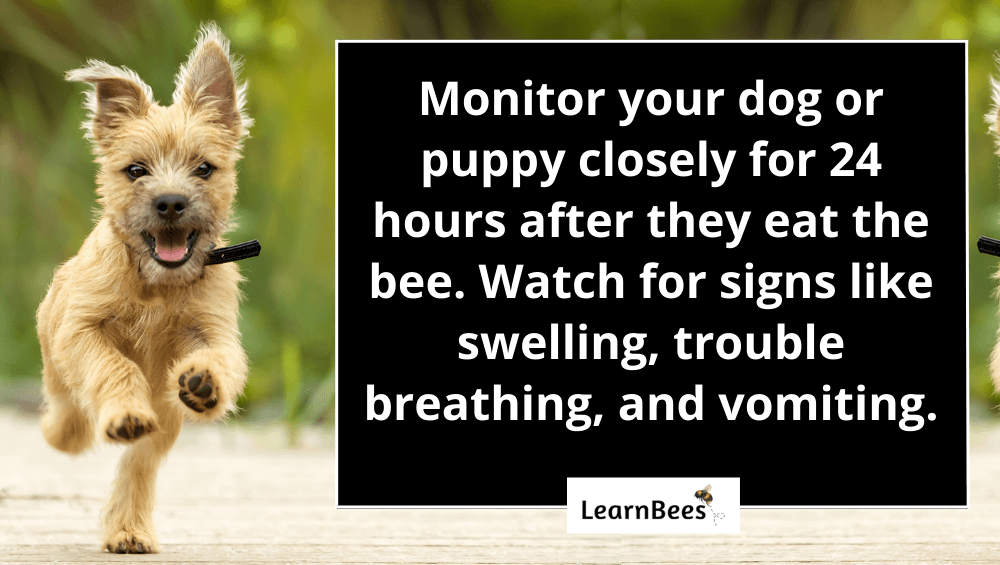
For starters, watch your dog or puppy closely for the first 24 hours after they eat the bee. Severe bee reactions will typically rear their ugly head during that timeframe.
More specifically?
Keep a lookout for these symptoms:
- Swelling
- Excess drooling
- Pawing at their mouth
- Watery eyes
- Heavy or troubled breathing
- Lethargic behavior
- Excess vomiting
- Diarrhea
If your dog or puppy is experiencing any of the above signs, please contact your vet immediately.
Now keep in mind:
Most dogs handle bee stings with zero problems. Sometimes your dog will swallow the bee whole without getting stung. As a result, your dog will simply digest the bee as a source of protein.
But in some cases?
Your vet might recommend keeping a bottle of Benadryl handy for minor bee and wasp stings. Benadryl is especially helpful during the spring and summer when bees and wasps are active.
And in case you didn’t know:
Benadryl is an antihistamine used for both humans and pets. It relieves symptoms of rash, itching, watery eyes, runny nose, and sneezing. It can also treat nausea, vomiting, and dizziness.(1, 2)
We recommend this children’s Benadryl because it’s free of alcohol and dyes.
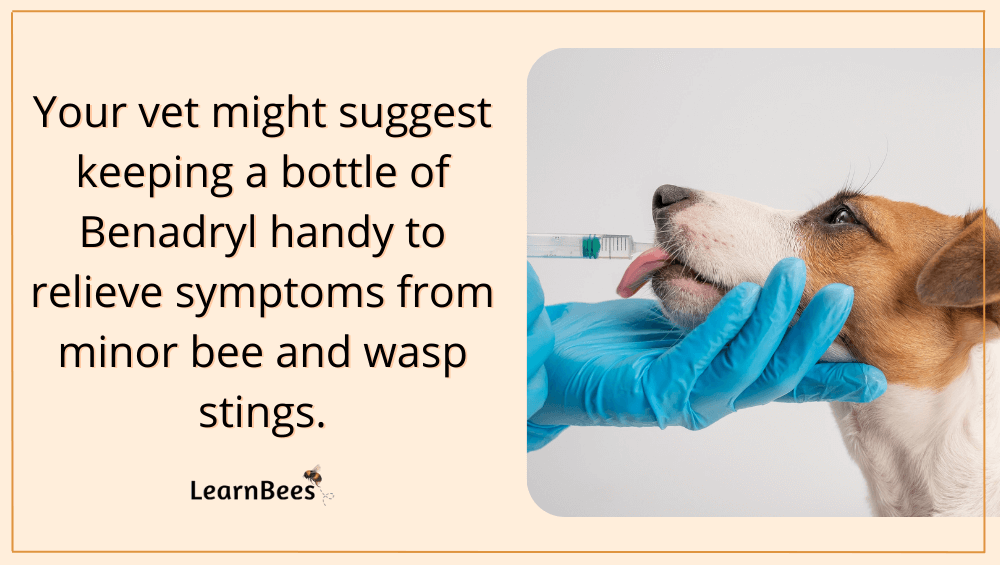
According to the Merck Veterinary Manual, the safe Benadryl dosage for dogs is 0.9 to 1.8 milligrams per pound of weight. If you’re using kilograms, that’s 2 to 4 milligrams of medication per kilogram of weight.(3)
Benadryl can be given two to three times daily, depending on your dog’s symptoms. You may also need a pack of syringes to give the Benadryl via your dog’s mouth.(4)
With that in mind:
Always get the green light from your vet before giving new medications to your pets.
And here’s the thing:
It’s important to remember that not all bees and wasps sting.
You might be surprised to learn that only female bees and wasps can sting. Males can’t sting because they don’t have stingers. Stingers are modified egg-laying devices, so only female bees and wasps have them.
Now you might be asking:
If my dog ate a bee, when should I become concerned?
You should take your dog to the vet immediately if they’re experiencing any of the symptoms listed here.

For example, if you notice severe swelling on your dog’s face or neck. This is a problem because the swelling may cause a blockage in your pet’s airway, making it hard for them to breathe.(5)
In this case, take your dog to the vet right away.
On the other hand, your dog may experience light vomiting after eating a bee. The bee or wasp could be at the base of your dog’s throat, and your dog is simply trying to cough it up. It’s a natural response.
But that said:
If the hacking or vomiting behavior happens more than a couple of times, you should contact your vet.
Now that brings us to the next question…
How Can My Vet Help if My Dog Ate a Bee?
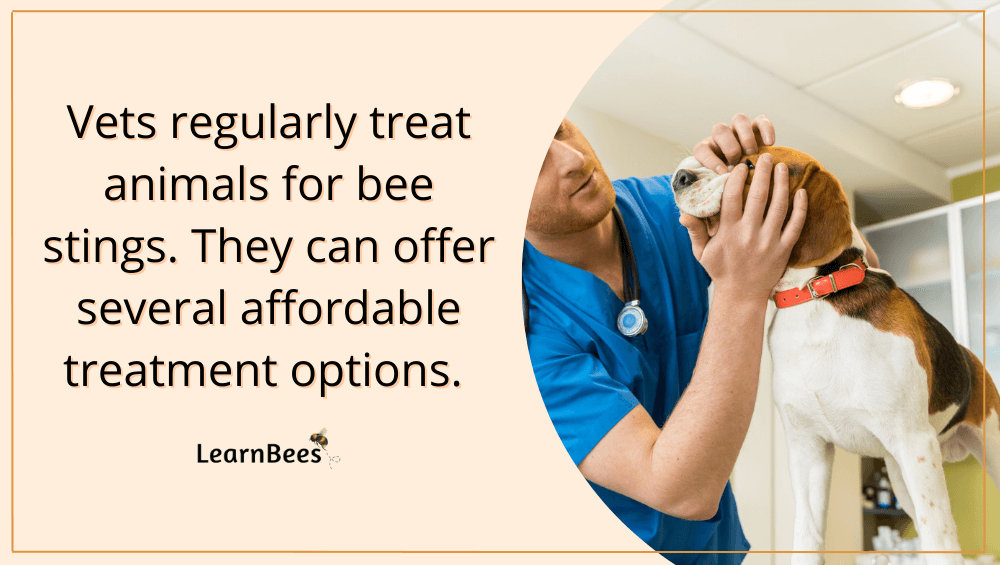
The good news?
Your vet sees this kind of thing more often than you might think. It’s no secret that dogs love chasing bees, wasps, and other flying insects.
So your vet can provide several treatment options, such as:
- Topical lidocaine to ease pain
- Corticosteroid cream to reduce inflammation
- A steroid injection to decrease swelling
- An antihistamine prescription like Benadryl to relieve symptoms
And thankfully:
A vet visit with these treatment options is usually reasonably priced. For example, at my local vet, an exam fee, steroid injection, and an antibiotic cost me less than $100.
On the other hand?
If your dog ate a bee and has a severe reaction, it could be a sign of anaphylaxis. Anaphylaxis is a severe, life-threatening reaction that can happen within minutes of exposure to an allergen.(6)
As such, your vet might prescribe your dog epinephrine (sometimes called “Epipen”).
An epinephrine injection is an emergency treatment of severe allergic reactions to insect stings or other substances.(7)
How Can I Treat Mild Stings At Home?
The most common symptoms of bee stings are mild.
For example, your dog may experience redness and sensitivity around the sting site. Such symptoms should decrease within the next 24 hours. And hopefully, your dog will learn not to mess with bees or wasps.
Wishful thinking, right?
Now here are a few steps to take if your dog ate a bee:
Step 1: Inspect Your Dog’s Mouth

You want to check for swelling or irritation and remove any potential stingers left behind. Honeybee stingers have small venom sacs that poke out of the skin. They may be tricky to see because they’re tiny.
So my suggestion?
Use a flashlight and extra helper to assist you when checking your dog’s mouth.
If you see a bee stinger, gently scrape it out with a credit card or your fingernail. Avoid pinching or pulling, as that can release more venom from the venom sac.
Here’s a video demonstrating the process:
Keep in mind that only honeybees leave their stingers behind. Other bees or wasps, like bumblebees and paper wasps, don’t have stingers that get stuck in the skin.
How come?
Because honeybees have barbed stingers with hooks on them. These hooks get lodged into the skin and left behind once the bee flies away. Once a honeybee loses its stinger, it dies.
Other bees or wasps have smooth stingers that don’t “hook” into you. This gives them the ability to sting multiple times.
Step 2: Closely Watch Your Dog For Atleast 24 Hours
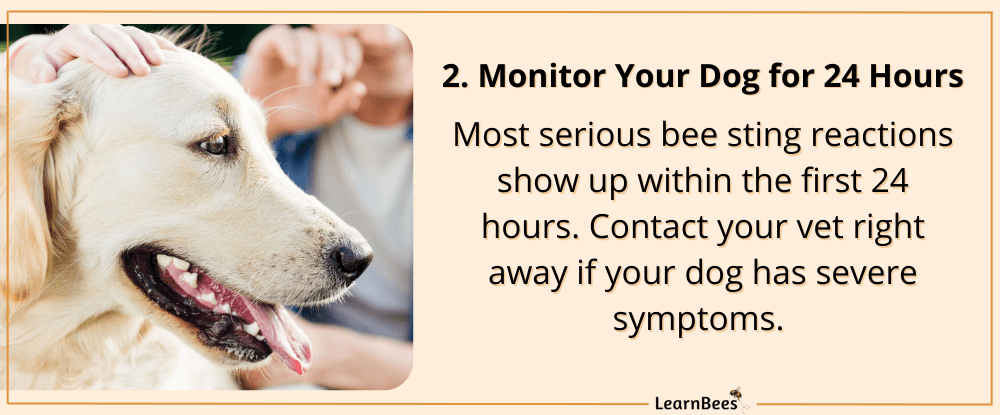
If your dog ate a bee and is prone to a severe reaction, it’ll likely happen within the first 24 hours. So watch out for the following symptoms:
- Swelling
- Heavy or troubled breathing
- Lethargic behavior
- Excess drooling
- Pawing at their mouth
- Watery eyes
- Excess vomiting
- Diarrhea
If your dog is experiencing any of the above symptoms, please contact your vet immediately.
Step 3: Check Your Property for Wasp Or Bee Nests
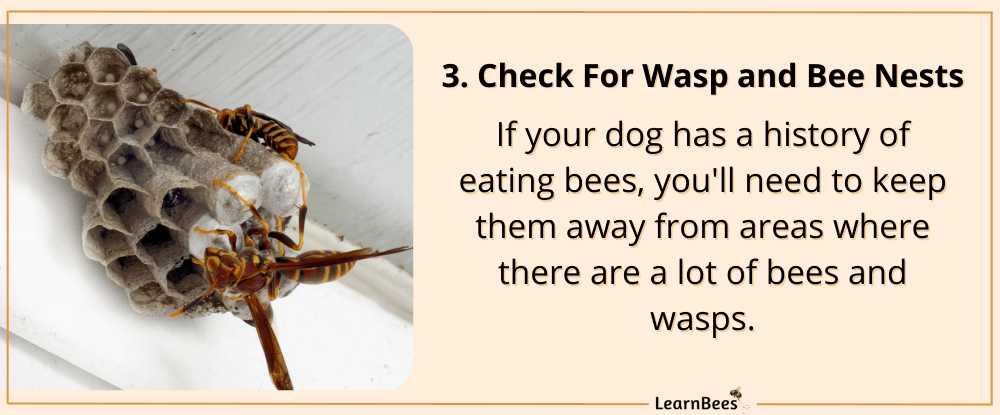
If you have a stubborn pup who has eaten bees before, you may need to keep them away from areas with heavy bee traffic.
To take it a step further, you might need to call a local beekeeper to remove any beehives close by.
But let me be clear:
Don’t try to kill the bees or move them yourself.
Beekeepers are experienced with relocating bees safely without hurting them.
For wasp or honest nests, you can knock their nests down in the fall once they’ve abandoned them. Most wasp species don’t survive the winter, so they begin dying off once the summer ends.
And here’s a trick:
Spray peppermint oil under the eaves of your porch, carport, garage, or shed to deter future wasp nests. Do this in the spring before the wasps start nesting.
This works because the smell of peppermint repels wasps.
But remember:
Only spray peppermint oil in places where your dog can’t reach it. Essential oils are potent and potentially unsafe for your dog if they ingest them.
Also, you can hang decoy wasp nests in the early spring to help deter wasps. Wasps are territorial and don’t like building nests next to other wasps.
FAQs on What to Do If Your Dog Ate a Bee
- My puppy ate a bee, should I worry?
- Why do dogs chase bees and wasps?
- Will eating a bee or wasp poison my dog?
- How long do symptoms appear after my dog eats a bee or wasp?
- What happens if a dog eats a bee?
- Should I worry if my dog ate a bee?
- What do I do if my dog ate a bee and threw up?
- What do I do if my dog ate a dead bee or wasp?
- My dog ate a bee but didn’t get stung, should I worry?
- How often do dogs eat bees or wasps?
- Should I remove bee or wasp nests to prevent my dog from getting stung?
My puppy ate a bee, should I worry?
In most cases, your puppy should be fine.
However, you should monitor them closely for the first 24 hours. Look out for symptoms such as swelling, heavy breathing, lethargy, excess drooling, pawing at the mouth, watery eyes, vomiting, and diarrhea.
Due to their young age and smaller size, puppies may be more prone to severe reactions than adult dogs. In the case of a severe reaction, contact your vet immediately.
That said, not all bees can sting.
For example, only female bees can sting. Male bees cannot because they don’t have stingers. So your puppy could’ve potentially eaten a bee that doesn’t sting, which means there’s likely no cause for concern.
—> Go back to the FAQs on What to Do If Your Dog Ate a Bee
More to Explore:
Why do dogs chase bees and wasps?
There are several reasons why dogs might chase bees and wasps.
For one, dogs have an instinct to hunt prey, and bees and wasps may be seen as good targets. Another reason is that bees and wasps make a buzzing sound when they fly, attracting a dog’s attention.
Some dogs may also be curious about bees and wasps and want to investigate them further.
Whatever the case, it’s essential to keep an eye on your dog if they’re exhibiting this behavior.
—> Go back to the FAQs on What to Do If Your Dog Ate a Bee
More to Explore:
Will eating a bee or wasp poison my dog?
No, bees are not poisonous.
However, some dogs are more sensitive to bees than others and may react to a sting.
If your dog shows signs of vomiting, lethargy, swelling, heavy breathing, pawing at the mouth, or other concerning symptoms after eating a bee, it’s best to seek medical attention.
—> Go back to the FAQs on What to Do If Your Dog Ate a Bee
More to Explore:
How long do symptoms appear after my dog eats a bee or wasp?
Symptoms of a bee or wasp sting can appear minutes to hours after your dog has ingested the bee. That’s why it’s best to closely observe your dog for 24 hours after they’ve eaten a bee or wasp.
—> Go back to the FAQs on What to Do If Your Dog Ate a Bee
More to Explore:
What happens if a dog eats a bee?
In most cases, your dog will experience some slight redness and irritation. After 24 hours, these mild symptoms will reduce.
However, in some cases, your dog may experience more severe symptoms such as difficulty breathing, pawing at the mouth, swelling of the lips, tongue, or throat, vomiting, and diarrhea. If your dog experiences any of these symptoms, it’s best to seek vet help.
—> Go back to the FAQs on What to Do If Your Dog Ate a Bee
More to Explore:
- Do Carpenter Bees Pollinate?
- How Long Do Bumble Bees Live?
- Honeybees vs. Bumblebees: How Do They Compare?
Should I worry if my dog ate a bee?
People often ask questions like:
My dog ate a bee and got stung in the mouth, should I be concerned? What do I give a dog who ate a bee? What to do if a dog eats a bee? What are the signs my dog ate a bee? How to tell if your dog ate a bee?
It’s normal to be worried after your dog gets stung. You’re just a good pet parent.
The good news is that most dogs handle one to two bee stings just fine. You should watch your dog closely to ensure they don’t develop pain or swelling. If this happens or your dog has been stung several times, please contact your vet.
Most serious symptoms will develop within the first 24 hours.
—> Go back to the FAQs on What to Do If Your Dog Ate a Bee
More to Explore:
What do I do if my dog ate a bee and threw up?
People regularly ask, “Should I be worried if my dog ate a bee and is throwing up?”
The answer is: it depends.
It can be normal for your dog to try to hack up the ingested bee. This is a natural response because they’re trying to get the bee out of their system. The vomiting can happen for a few minutes, not long after your dog ate the bee.
Note:
Vomiting for several hours or days isn’t normal. Please contact your veterinarian right away if this happens.
—> Go back to the FAQs on What to Do If Your Dog Ate a Bee
More to Explore:
- Ground Bees: Are They a Threat to Your Yard?
- Wasps vs. Honeybees: Are They Different?
- Do Bumble Bees Bite?
What do I do if my dog ate a dead bee or wasp?
Dead bees and wasps can’t sting, so it’s unlikely that this should be concerning. Your dog will just digest the bee as protein.
But as mentioned, monitor your dog closely for at least the first 24 hours for signs of a severe reaction.
—> Go back to the FAQs on What to Do If Your Dog Ate a Bee
More to Explore:
My dog ate a bee but didn’t get stung, should I worry?
In most cases, no. If your dog didn’t get stung, you usually have very little to worry about.
—> Go back to the FAQs on What to Do If Your Dog Ate a Bee
More to Explore:
How often do dogs eat bees or wasps?
It’s not uncommon for dogs to chase bees and wasps. That said, it depends on your dog. Some dogs are more active and hyper than others, so a buzzing bee will quickly grab their attention.
Most vets have treated bee stings in dogs before, so don’t be shy about calling your vet for help if you need it.
—> Go back to the FAQs on What to Do If Your Dog Ate a Bee
More to Explore:
Should I remove bee or wasp nests to prevent my dog from getting stung?
If you live in an area with high bee or wasp traffic, you should consider removing their nests.
But don’t forget:
We don’t recommend moving bee nests yourself. Instead, call a local beekeeper. They have experience relocating bees safely without hurting them.
As for removing wasps, knock their nests down in the fall. Wasps die off before the cool weather arrives, so they’ll abandon their nests. You can also spray peppermint oil around the eaves of your home, where wasps usually cohabitate.
Wasps hate the smell of peppermint oil, so they won’t nest where you’ve sprayed it. Spray it in the early spring and summer before wasp hatch.
Don’t spray peppermint oil on the ground where your dog can ingest it. Essential oils can be toxic to animals if they’re eaten.
Finally, you can also hang wasp decoy nests to deter wasps. Wasps don’t like building their nests next to other insects so the decoy nests will repel them.





